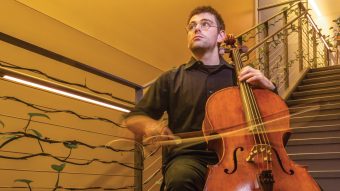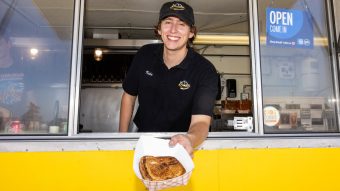Nov. 6, 2019
Contact: Austin Fitzgerald, 573-882-6217, fitzgeraldac@missouri.edu
On one of the last warm days of October, Natalie Eaton gently rubs the ears of Levi, a gleaming red dun horse that was just born in April but already stands near her shoulder level. She has just led him through a small obstacle course designed to teach him some fundamentals, such as learning to follow cues and step over hurdles. As sunlight filters into the barn on the grounds of the University of Missouri’s South Farm Research Center, Levi’s mane twitches, splaying over the diamond-shaped white splotch on his forehead.
“He’s younger than all the other horses here, so we’re planning on keeping him until next year for our auction,” said Natalie, a junior in MU’s animal sciences program who has been paired with Levi in the program’s equine behavior and training class.
She’s talking about the MU Equine Teaching Facility’s annual horse auction, which has been around in one form or another for much of the equine program’s nearly 60-year history. The auction’s current form — an online auction that doubles as a fundraiser for the program — is in its 13th year.

A preview of the auction will be held on Saturday, Nov. 9 from 10 a.m.-2 p.m. On Nov. 14, most of Levi’s companions will be sold to trainers and riders across the country — about half the horses will stay in Missouri. Come next year, a new group will take their place, and Levi will join them in the sale as a yearling. In the meantime, the student-run program is preparing the horses for their careers as work, show or recreational animals, all while providing students — many of whom have no prior experience with horses — with valuable experience in equine training and care.
“I started volunteering out here with no horse experience at all,” said Anna Haberberger, a senior in the animal sciences program. “I decided to go ahead and take some classes, and I found that I had a real love for horses and for working with them.”
The program is divided into a number of courses and volunteer opportunities focusing on different aspects of horse care, training and the auction itself. In summer and fall, students help the horses acclimatize to their environment by getting them used to saddles and training them in obstacle courses. Students can also volunteer to feed the horses each morning and night, a role that serves as many students’ first exposure to the program. In addition, a management and marketing course gives students the opportunity to stage and promote the auction.
“Through hands-on, experiential learning, we try to provide our students with the scientific information they need for management decisions,” said Hannah Twenter, one of the program’s instructors. “This program does a fantastic job of giving them the experience and the skills that they need to become well-rounded horsemen and women prior to going into the industry.”
As Twenter speaks, another horse is led through the course around her, stepping over obstacles and weaving through cones as if learning the moves to a simple but precise dance. Horse and trainer move almost as a single unit, a testament to the bond they have developed in their weeks together. Marci Crosby, the director of the equine program, said the communication styles between horse and trainer play an important role in deciding who is paired with which horse.

“Just like people, some horses are more outgoing and some are more reserved,” Crosby said. “It is my goal to pair students with a horse that will help our students develop new skills. The first two weeks of class are always about figuring out the dynamics between the horses and students.”
If history is anything to go by, that approach pays off. The auction is consistently successful and the proceeds go straight back into the program, ensuring that future students can continue to learn about horsemanship through real-life, hands-on experiences. This year, the auction is selling five horses and a mule, in keeping with the average of five to eight horses per auction.
For now, horse and trainer are taking things slowly, one hurdle at a time.
*Editor’s Note: For more information, you can visit this year’s auction page here.



